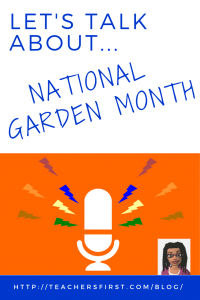 April is the ideal time to observe National Garden Month. Winter is over. Growing cycles are starting again here in North America. It’s the perfect time to celebrate with Mother Nature.
April is the ideal time to observe National Garden Month. Winter is over. Growing cycles are starting again here in North America. It’s the perfect time to celebrate with Mother Nature.
There are a lot of reasons why students in school should be involved in gardening activities. It fosters a Maker Mindset – a bent towards innovation which asks “what can I do with what I know.” Gardening at school is also a great STEM activity which has an added benefit of teaching life skills.
Here are a few of the objectives that students can work towards when gardening at school:
Science – using sensory observations to understand physical properties; understanding basic life needs and functional parts of plants; the effects of seasonal change on plants
Technology – can be used to collect and analyze data; communicate in a variety of ways including reaching out for expert advice and retelling the story of an event
Engineering/Design process – problem solving steps to design gardening solutions
Math – accurate measurement for planning when planting; collecting, understanding probability and statistics through analyzing and presenting growth data
Life Skills
- Environmental Responsibility – We’ve all heard that we need to save the bees. Gardens provide a bee-friendly environment that all of our students can easily have a stake in creating.
- Patience – Part of gardening is waiting for things to grow. You can’t rush the process no matter what you try. Students will learn to anticipate their harvest while waiting for plants to mature.
- Nutrition – Students who typically don’t eat vegetables might agree to try them if it’s something they’ve grown with their own hands. Who knows? They might find they like them…
- Resilience – Gardening doesn’t always work out the way you hope it will, but you can’t give up. Students will learn to recover from temporary setbacks.
Want to learn more about gardening with students? Check out these resources and then leave us a comment to let us know how you plan to infuse gardening in your school.
- Project Budburst (Reviewed here)


National Garden Month has been a great theme in my biology classes! Without realizing it, this post showed how the cross-curricular component is present and can be developed even further.
Designing a controlled experiment (I used daffodils because they bloom in spring) is science.
Quantitative observations (math) and qualitative observations.
Creating a shared google document for multiple class data calculation (technology).
Next year I am going to add the vegetable side and use it to parallel with nutrition!